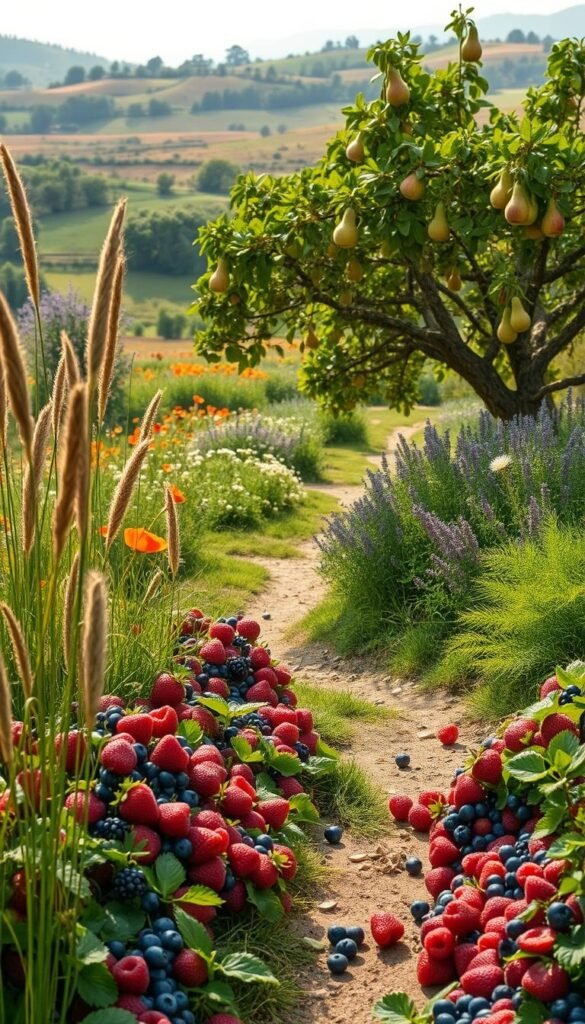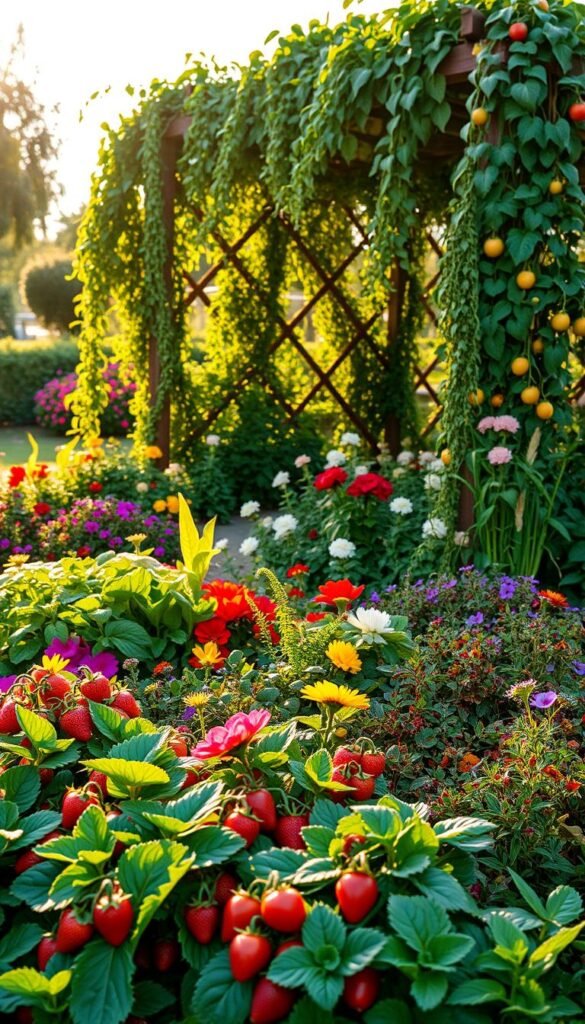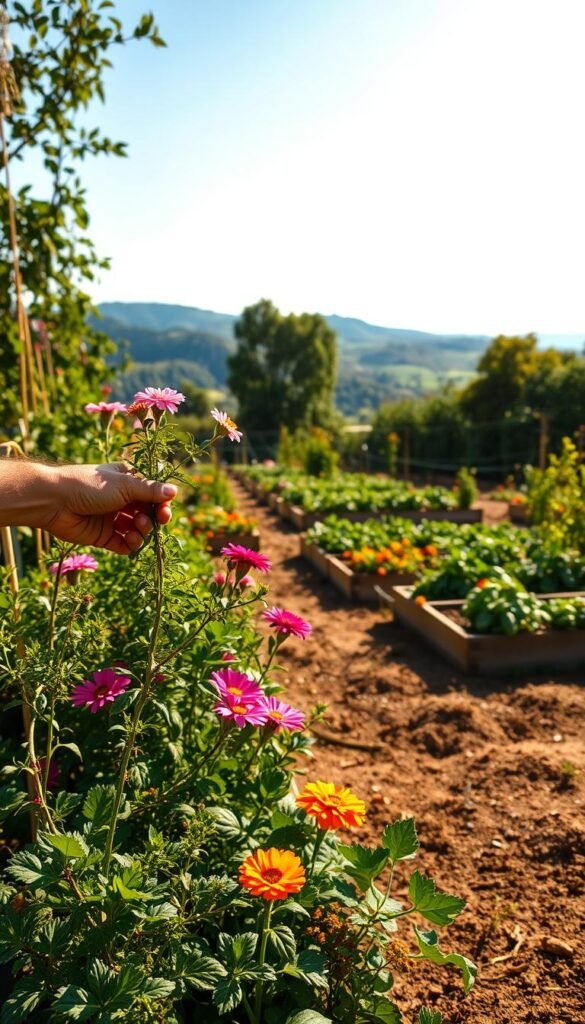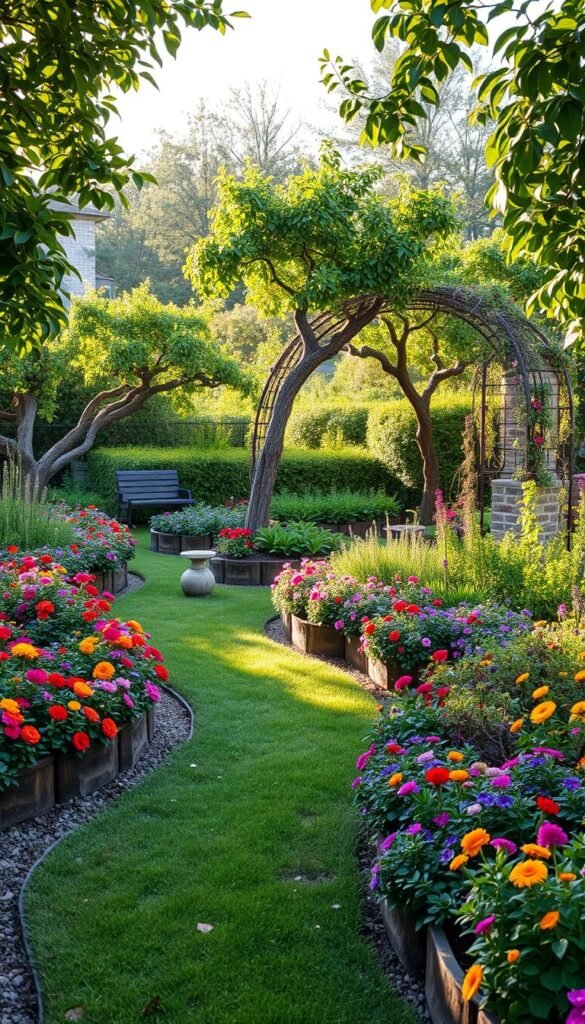Imagine stepping into a space where vibrant colors meet fresh flavors. Gone are the days of choosing between pretty blooms and practical harvests. A growing trend in outdoor design proves you can have both visual charm and delicious rewards in one cohesive landscape.
This approach centers on “edimentals”—plants that work double duty. Think ruby-hued Swiss chard with its ruffled leaves or fragrant lavender bushes buzzing with pollinators. These multitaskers erase the old divide between flower beds and vegetable patches, creating spaces that delight the senses while putting food on your table.
Why settle for single-purpose plantings when you can maximize every square foot? Edible landscaping offers clever solutions for tight urban yards or sprawling rural properties. You’ll attract beneficial insects, reduce grocery trips, and gain ingredients that transform ordinary meals into culinary adventures.
Beyond practicality, this style celebrates seasonal rhythms. Picture spring blossoms giving way to summer berries, followed by autumn’s fiery foliage and winter’s structural interest. Your outdoor area becomes a living canvas that evolves while nourishing your household.
Getting Started with Your DIY Fruit Garden

Your journey begins by reimagining ordinary green spaces as productive art. Landscape expert Christian Douglas notes:
“Food-forward design starts with embracing your site’s unique personality—every challenge becomes a creative opportunity.”
Understanding the Concept of Edimentals
Edimentals are nature’s multitaskers. These special varieties like purple kale or golden raspberries deliver striking visual appeal and tasty rewards. They turn borders into snack stations and flower beds into salad bars.
Assessing Your Space and Lighting Conditions
Start by observing sunlight patterns. Most productive varieties need 6+ hours of direct sun. Use free tools like Sunseeker to map shadows through seasons. Watch how light dances across your:
- Morning patio corners
- Afternoon deck surfaces
- Dappled areas under trees
Sloped terrain? Try terraced planters. Deer visitors? Install motion-activated sprinklers. Focus first on one manageable area—a container collection or raised bed—to build confidence. Success grows from small, smart beginnings.
DIY Fruit Garden Aesthetic: Blending Beauty with Edible Bounty in Your Landscape

Transform your yard into a living pantry that dazzles the eye. Professional designers use three-dimensional layering to craft spaces where every plant pulls double duty. Start by mapping vertical layers – tall specimens create natural ceilings, while low growers form edible carpets.
Smart Layering for Year-Round Appeal
Canopy trees like persimmons offer summer shade and autumn fireworks. Mid-height shrubs such as pomegranates add sculptural forms. “Ground-level plantings should surprise and delight,” suggests designer Mara Hoffman. “Tuck alpine strawberries between stepping stones – their white flowers peek through leaves like hidden jewels.”
Curating Productive Plant Partners
Swap boring boxwoods for blueberry bushes that blush crimson in fall. Replace ivy with creeping thyme that releases fragrance underfoot. For vertical accents, train grapevines on arbors instead of wisteria. These varieties work harder than traditional ornamentals while keeping your salad bowl full.
Remember: successful edible landscapes balance form and function. Pair silver-leafed lavender with ruby chard for color contrast. Mix feathery dill fronds against bold artichoke leaves. Your space becomes a living gallery where every plant earns its place through beauty and bounty.
Designing a Visually Stunning and Functional Edible Landscape

Turn your outdoor space into a living palette where every plant serves two purposes: eye candy and supper ingredients. Professional designers achieve this balance through strategic pairings that excite both taste buds and retinas.
Mixing Colors and Textures for Pop and Contrast
Create drama with foliage that rivals blooms. Pair purple basil’s deep hues with silver lavender leaves for instant contrast. Red-veined sorrel adds burgundy streaks to green beds, while rainbow Swiss chard stems work like living paintbrushes.
| Color Combo | Plant Pair | Visual Effect |
|---|---|---|
| Burgundy + Silver | Red Sorrel + Lavender | Metallic contrast |
| Sunset Palette | Rainbow Chard + Marigolds | Warm color bursts |
| Deep Purple + Chartreuse | Basil + Lemon Thyme | Electric vibrancy |
Using Fruits, Vegetables, and Flowers as Borders and Accents
Swap traditional hedges for productive edges. Rosemary makes fragrant borders you can snip for roast chicken. Curly kale’s ruffled leaves frame paths better than boring boxwood. For vertical flair, train passionfruit vines on trellises—they’ll give you tropical blooms and exotic fruits.
Edible flowers like nasturtiums pull double duty: their orange petals brighten salads and garden beds. Want structural height? Try espaliered apple trees against walls—they save space while creating living art. Your landscape becomes a feast for eyes and plate.
Practical Tips for Seasonal Garden Maintenance and Growth

Keep your edible oasis thriving through changing weather with smart care strategies. Chef Teresa Kao from The French Laundry advises:
“Healthy plants start with daily observation—spot discolored leaves or stunted growth early, and you’ll prevent bigger headaches later.”
Watering, Soil Care, and Pest Management
Water deeply but less frequently to encourage strong roots. Morning irrigation reduces evaporation and fungal risks. For soil health, mix compost into beds each spring and plant winter cover crops like oats or field peas. These “green blankets” protect earth while boosting nutrients.
Combat pests organically using Kao’s three-step approach:
- Blast aphids off leaves with a hose spray
- Drape row covers over cabbage to block moths
- Release ladybugs to devour mealybugs
Vertical Gardening and Space Optimization Techniques
Grow upward with trellised cucumbers or pole beans. Hang strawberry planters from sunny eaves. Try succession planting—swap harvested spinach spots with heat-loving peppers. Companion pairs like basil and tomatoes save space while enhancing flavors.
Rotate crops yearly to prevent soil depletion. Follow heavy feeders (like corn) with nitrogen-fixing peas. Your kitchen will overflow with fresh produce, and pollinators will flock to your thriving patch.
Bringing Your DIY Fruit Garden Aesthetic to Life
Crafting a living landscape that feeds both body and soul starts with smart plant partnerships. Landscape designer Stefani Bittner suggests treating perennial edibles as garden elders—reliable producers like fig trees or rosemary bushes that anchor your space through seasons. These hardy staples create structure while annuals like cherry tomatoes add seasonal flair.
Balance beauty and function by mixing textures and purposes. Silver-leafed artichokes make striking focal points, while creeping thyme forms fragrant living carpets between stones. For vertical drama, train grapevines over arbors—their autumn leaves rival any ornamental vine.
Attract helpful pollinators by planting bee favorites among your crops. Lavender spikes and sunflower blooms brighten garden beds while supporting local wildlife. Under fruit trees, try shade-tolerant strawberries as edible ground cover that sweetens your harvests.
Create outdoor living zones where lemon trees dapple patio shade and mint grows arm’s reach from seating areas. This approach lets you snack on sun-warmed blueberries while relaxing, turning your yard into a multi-sensory retreat.
Whether you nurture low-maintenance olives or daily-picked greens, your landscape becomes a personal sanctuary. Each season brings new flavors and colors, proving practical spaces can nourish both pantry and spirit.






